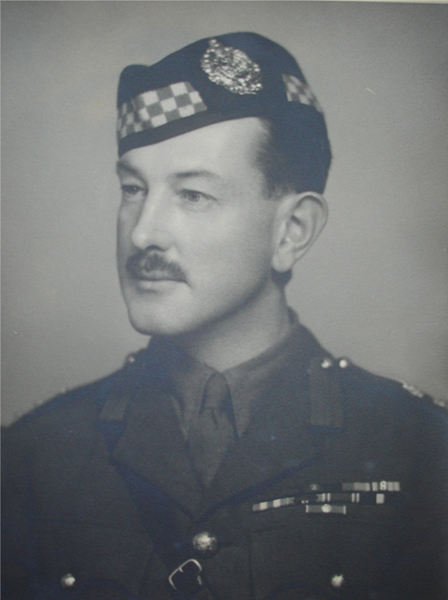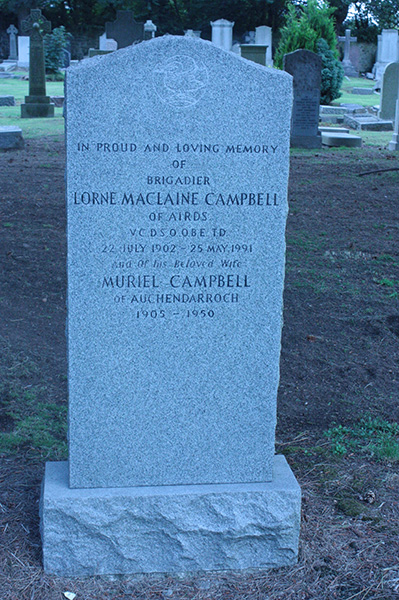Campbell, Lorne MacLaine
- Date of birth:
- July 22nd, 1902 (The Airds/Argyllshire, Scotland)
- Date of death:
- May 25th, 1991 (The Airds/Argyllshire, Scotland)
- Buried on:
- Warriston Cemetery
- Service number:
- 16220
- Nationality:
- British
Biography
Promotions:
?: Major;
?: Lieutenant-Colonel (war subs.);
?: Acting Brigadier;
?: Temporary Brigadier;
April 11th, 1945: Lieutenant-Colonel;
April 11th, 1945: Colonel.
Do you have more information about this person? Inform us!
- Period:
- Second World War (1939-1945)
- Rank:
- Major
- Unit:
- 8th Battalion Argyll and Sutherland Highlanders, 154th Infantry Brigade, 51st (Highland) Infantry Division, British Army
- Awarded on:
- October 18th, 1940
(signed) Brigadier 154 Infantry Brigade.
- Period:
- Second World War (1939-1945)
- Rank:
- Major
- Unit:
- 7th Battalion Argyll and Sutherland Highlanders, 28th Infantry Brigade, 51st (Highland) Infantry Division, British Army
- Awarded on:
- April 29th, 1941
Received for distinguished services in the field.
LG 35146/2425.
LG 35146/2425.
- Period:
- Second World War (1939-1945)
- Rank:
- Major
- Unit:
- 7th Battalion Argyll and Sutherland Highlanders, 28th Infantry Brigade, 51st (Highland) Infantry Division, British Army
- Awarded on:
- December 2nd, 1941
LG 35363/6876.
- Period:
- Second World War (1939-1945)
- Rank:
- Temporary Lieutenant-Colonel
- Unit:
- 7th Battalion Argyll and Sutherland Highlanders, 28th Infantry Brigade, 51st (Highland) Infantry Division, British Army
- Awarded on:
- May 4th, 1943
---
"In the four-mile attack into the enemy defences on night 23/24 October 1942 Colonel Campbell's Battalion suffered heavily, especially among officers, but greatly due to his own outstanding powers of leadership and the personal control which he exercised they captured their first three objectives.
Three nights later they went on to gain their fourth and final objective. By this time the casualties in the Battalion numbered 250, including all the company commanders and the best and most experienced of their officers.
Late on the 3rd November Colonel Campbell was ordered to capture a feature, vital to the passage of armoured forces, before light the next morning.
This action involved a hurried reconnaissance four miles distant during the last half-hour of light, the complete organisation for the attack on his return, the moving forward of his battalion with supporting arms on a moonless night through desert which he had only seen as he moved quickly forward to his reconnaissance, the forming up of his battalion and a starting line which he had never seen, and the capture of the objective 3000 yards distant.
To the average commander such an operation was not 'on' but the fact that Colonel Campbell carried it through with no officers of any seniority or experience to assist him, and up to scheduled time, is a full tribute to the character and qualities which this officer possesses."
Second DSO awarded in the form of a bar to be worn on the ribbon of the first DSO.
LG 36000/1995.
- Period:
- Second World War (1939-1945)
- Rank:
- Temporary Lieutenant-Colonel
- Unit:
- 7th Battalion Argyll and Sutherland Highlanders, 28th Infantry Brigade, 51st (Highland) Infantry Division, British Army
- Awarded on:
- June 8th, 1943
Recommendation:
"On the 6th April, 1943, in the attack upon the Wadi Akarit position, the task of breaking through the enemy minefield and antitank ditch to the East of the Roumana feature and of forming the initial bridgehead for a Brigade of the 5ist Highland Division was allotted to the Battalion of the Argyll and Sutherland Highlanders commanded by Lieutenant-Colonel Campbell.
The attack had to form up in complete darkness and had to traverse the main offshoot of the Wadi Akarit at an angle to the line of advance. In spite of heavy machinegun and shell fire in the early stages of the attack, Lieutenant-Colonel Campbell successfully accomplished this difficult operation, captured at least 600 prisoners and led his Battalion to its objective, having to cross an unswept portion of the enemy minefield in doing so.
Later, upon reaching his objective he found that a gap which had been blown by the Royal Engineers in the anti-tank ditch did not correspond with the vehicle lane which had been cleared in the minefield. Realising the vital necessity of quickly establishing a gap for the passage of anti-tank guns, he took personal charge of this operation. It was now broad daylight and, under very heavy machine-gun fire and shell fire, he succeeded in making a personal reconnaissance and in conducting operations which led to the establishing of a vehicle gap.
Throughout the day Lieutenant-Colonel Campbell held his position with his Battalion in the face of extremely heavy and constant shell fire, which the enemy was able to bring to bear by direct observation.
About 1630 hours determined enemy counter-attacks began to develop, accompanied by tanks. In this phase of the fighting Lieutenant-Colonel Campbell's personality dominated the battle field by a display of valour and utter disregard for personal safety, which could not have been excelled.
Realising that it was imperative for the future success of the Army plan to hold the bridgehead his Battalion had captured, he inspired his men by his presence in the forefront of the battle, cheering them on and rallying them as he moved to those points where the fighting was heaviest.
When his left forward company was forced to give ground he went forward alone, into a hail of fire and personally reorganised their position, remaining with the company until the attack at this point was held. As reinforcements arrived upon the scene he was seen standing in the open directing the fight under close range fire of enemy infantry and he continued to do so although already painfully wounded in the neck by shell fire. It was not until the battle died down that he allowed his wound to be dressed. Even then, although in great pain, he refused to be evacuated, remaining with his Battalion and continuing to inspire them by his presence on the field.
Darkness fell with the Argylls still holding their positions, though many of its officers and men had become casualties.
There is no doubt that but for Lieutenant-Colonel Campbell's determination, splendid example of courage and disregard of pain, the bridgehead would have been lost. This officer's gallantry and magnificent leadership when his now tired men were charging the enemy with the bayonet and were fighting them at hand grenade range, are worthy of the highest honour, and can seldom have been surpassed in the long history of the Highland Brigade."
Lieutenant Campbell’s Victoria Cross is publicly displayed at the Argyll and Sutherland Highlanders Museum in Stirling Castle in Scotland.
LG 36045/2623.
"On the 6th April, 1943, in the attack upon the Wadi Akarit position, the task of breaking through the enemy minefield and antitank ditch to the East of the Roumana feature and of forming the initial bridgehead for a Brigade of the 5ist Highland Division was allotted to the Battalion of the Argyll and Sutherland Highlanders commanded by Lieutenant-Colonel Campbell.
The attack had to form up in complete darkness and had to traverse the main offshoot of the Wadi Akarit at an angle to the line of advance. In spite of heavy machinegun and shell fire in the early stages of the attack, Lieutenant-Colonel Campbell successfully accomplished this difficult operation, captured at least 600 prisoners and led his Battalion to its objective, having to cross an unswept portion of the enemy minefield in doing so.
Later, upon reaching his objective he found that a gap which had been blown by the Royal Engineers in the anti-tank ditch did not correspond with the vehicle lane which had been cleared in the minefield. Realising the vital necessity of quickly establishing a gap for the passage of anti-tank guns, he took personal charge of this operation. It was now broad daylight and, under very heavy machine-gun fire and shell fire, he succeeded in making a personal reconnaissance and in conducting operations which led to the establishing of a vehicle gap.
Throughout the day Lieutenant-Colonel Campbell held his position with his Battalion in the face of extremely heavy and constant shell fire, which the enemy was able to bring to bear by direct observation.
About 1630 hours determined enemy counter-attacks began to develop, accompanied by tanks. In this phase of the fighting Lieutenant-Colonel Campbell's personality dominated the battle field by a display of valour and utter disregard for personal safety, which could not have been excelled.
Realising that it was imperative for the future success of the Army plan to hold the bridgehead his Battalion had captured, he inspired his men by his presence in the forefront of the battle, cheering them on and rallying them as he moved to those points where the fighting was heaviest.
When his left forward company was forced to give ground he went forward alone, into a hail of fire and personally reorganised their position, remaining with the company until the attack at this point was held. As reinforcements arrived upon the scene he was seen standing in the open directing the fight under close range fire of enemy infantry and he continued to do so although already painfully wounded in the neck by shell fire. It was not until the battle died down that he allowed his wound to be dressed. Even then, although in great pain, he refused to be evacuated, remaining with his Battalion and continuing to inspire them by his presence on the field.
Darkness fell with the Argylls still holding their positions, though many of its officers and men had become casualties.
There is no doubt that but for Lieutenant-Colonel Campbell's determination, splendid example of courage and disregard of pain, the bridgehead would have been lost. This officer's gallantry and magnificent leadership when his now tired men were charging the enemy with the bayonet and were fighting them at hand grenade range, are worthy of the highest honour, and can seldom have been surpassed in the long history of the Highland Brigade."
Lieutenant Campbell’s Victoria Cross is publicly displayed at the Argyll and Sutherland Highlanders Museum in Stirling Castle in Scotland.
LG 36045/2623.
- Period:
- Second World War (1939-1945)
- Rank:
- Acting Brigadier
- Awarded on:
- January 13th, 1944
LG 36327/266.
- Period:
- Second World War (1939-1945)
- Rank:
- Temporary Brigadier
- Awarded on:
- August 24th, 1944
LG 36668/3933.
- Period:
- Second World War (1939-1945)
- Rank:
- Temporary Brigadier
- Awarded on:
- June 23rd, 1945
LG 37184/3719.
- Period:
- Second World War (1939-1945)
- Rank:
- Colonel
- Awarded on:
- January 20th, 1947
LG 37909/1311.
Permission to wear the decoration was granted on January 20th, 1947.
Sources
- Photo: Wikimedia Commons
- Lorne Campbell's grave, Warriston Cemetery - - Supplement to The London Gazette of 25th April 1941, Issue 35146, dated 29th April 1941
- Second Supplement to The London Gazette of 28th November 1941, Issue 35363, dated 2nd December 1941
- Second Supplement to The London Gazette of 30th April 1943, Issue 36000, dated 4th May 1943
- Third Supplement to The London Gazette of 4th June 1943, Issue 36045, dated 8th June 1943
- Supplement to The London Gazette of 11th January 1944, Issue 36327, dated 13th January 1944
- Supplement to The London Gazette of 22nd August 1944, Issue 36668, dated 24th August 1944
- Supplement to The London Gazette of 17th July 1945, Issue 37184, dated 19th July 1945
- Second Supplement to The London Gazette of 17th July 1945, Issue 37185, dated 20th July 1945
- Second Supplement to The London Gazette of 5th February 1946, Issue 37459, dated 8th February 1946
- Supplement to The London Gazette of 18th March 1947, Issue 37909, dated 20th March 1947
- Recommendation for Award for Campbell, Lorne Maclaine Rank: Major Regiment: ... | The National Archives
- Recommendation for Award for Campbell, Lorne Maclaine Rank: Major, Temporary... | The National Archives
- British Army officers 1939-1945









